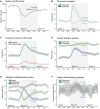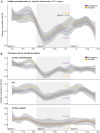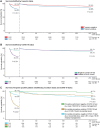Changes in the investigation and management of suspected myocardial infarction and injury during COVID-19: a multi-centre study using routinely collected healthcare data
- PMID: 38836064
- PMCID: PMC11148217
- DOI: 10.3389/fcvm.2024.1406608
Changes in the investigation and management of suspected myocardial infarction and injury during COVID-19: a multi-centre study using routinely collected healthcare data
Abstract
Objective: The COVID-19 pandemic was associated with a reduction in the incidence of myocardial infarction (MI) diagnosis, in part because patients were less likely to present to hospital. Whether changes in clinical decision making with respect to the investigation and management of patients with suspected MI also contributed to this phenomenon is unknown.
Methods: Multicentre retrospective cohort study in three UK centres contributing data to the National Institute for Health Research Health Informatics Collaborative. Patients presenting to the Emergency Department (ED) of these centres between 1st January 2020 and 1st September 2020 were included. Three time epochs within this period were defined based on the course of the first wave of the COVID-19 pandemic: pre-pandemic (epoch 1), lockdown (epoch 2), post-lockdown (epoch 3).
Results: During the study period, 10,670 unique patients attended the ED with chest pain or dyspnoea, of whom 6,928 were admitted. Despite fewer total ED attendances in epoch 2, patient presentations with dyspnoea were increased (p < 0.001), with greater likelihood of troponin testing in both chest pain (p = 0.001) and dyspnoea (p < 0.001). There was a dramatic reduction in elective and emergency cardiac procedures (both p < 0.001), and greater overall mortality of patients (p < 0.001), compared to the pre-pandemic period. Positive COVID-19 and/or troponin test results were associated with increased mortality (p < 0.001), though the temporal risk profile differed.
Conclusions: The first wave of the COVID-19 pandemic was associated with significant changes not just in presentation, but also the investigation, management, and outcomes of patients presenting with suspected myocardial injury or MI.
Keywords: COVID-19; emergency department; myocardial infarction; myocardial injury; troponin.
© 2024 Chammas, Yuan, Little, Roadknight, Varnai, Chang, Sze, Davies, Tsui, Salih, Glampson, Papadimitriou, Mulla, Woods, O'Gallagher, Shah, Williams, Asselbergs, Mayer, Lee, Herbert, Johnson, Grant, Curzen, Shah, Perera, Patel, Channon, Kaura, Mayet, Eyre, Squire, Kharbanda, Lewis and Wijesurendra.
Conflict of interest statement
The authors declare that the research was conducted in the absence of any commercial or financial relationships that could be construed as a potential conflict of interest.
Figures





References
-
- Pessoa-Amorim G, Camm CF, Gajendragadkar P, De Maria GL, Arsac C, Laroche C, et al. Admission of patients with STEMI since the outbreak of the COVID-19 pandemic: a survey by the European society of cardiology. Eur Heart J Qual Care Clin Outcomes. (2020) 6:210–6. 10.1093/ehjqcco/qcaa046 - DOI - PMC - PubMed
Grants and funding
LinkOut - more resources
Full Text Sources

